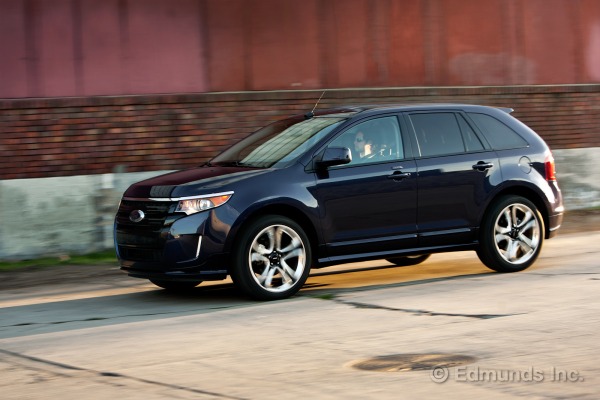
The 2011 Ford Edge was radically refreshed for this model year, and the reenergized Dearborn automaker also chose the vehicle to debut its slick new MyFord Touch Sync system. But the Sony premium audio system for the new Edge is virtually the same as in our former long-term Flex Limited.
We weren't exactly blown away by the Flex system, and the Sony setup I sound-checked in the 2011 Edge Sport has identical specs. Hit the jump to see if it performed any better.
The Setup
The Sony system in the 2011 Edge Sport consists of 12 speakers powered by 390 watts. These include a 1-inch tweeter in each A pillar, a 3-inch speaker in the center of the dash, a 5x7-inch midbass driver in each door, another 3-inch speaker in each D pillar and an 8-inch subwoofer in a sealed enclosure in the passenger-side wall of the rear cargo area. Ford is one of the few automakers that supplies specs on the power going to each speaker: 25 watts for each tweeter and 3-inch speakers, 35 watts for each 5x7 and 100 watts going to the 8-inch sub.
The Sound
As with every system I sound-check, I listened to about a dozen different musical tracks that I've heard in literally hundreds of vehicles to gauge clarity/lack of distortion, tonal balance, timbre, tonal accuracy, soundstaging, imaging and dynamics. I also used non-musical tracks to test soundstaging, imaging, linearity and absence of noise. For more details on this testing process and the tracks used, click on the Edmunds.com article Sound Advice.
Out of curiosity, I pulled the evaluation sheet on our former 2009 Ford Flex from my files and, unsurprisingly, the scores and comments were very similar. As in the Flex, sound quality for the Edge's Sony system was slightly above average in the categories of clarity, tonal balance, timbre, tonal accuracy and dynamics. And like the Flex -- as with many other middle-of-the-road car audio systems -- weak spots in the Sony setup were on the extremes of the audio spectrum: overly bright highs and boomy midbass. The 8-inch subwoofer seemed to produce slightly better low-bass than the same-size sub in the Flex, but it too easily distorted when pushed hard.
The Edge also excelled at staging and imaging. The A-pillar tweeters and center-channel speaker setup created an expansive stage with detailed image placement. Even though tonality suffered for reasons mentioned above, the system produced very good stereo separation, and the width and depth of the soundstage and precise imaging help make up for these deficiencies.
It easily passed the non-musical staging and imaging tests -- spoken voices that are mixed left, center and right and seven drum beats that march across the dash -- as well as a zero-bits/absence of noise test. And whereas the Flex earned a poor score in both linearity tests -- a measure of how well the sound holds together at low- and mid- volume levels -- the Edge rated poor and fair, respectively.
The Sources
The Edge has a single CD/DVD head unit that includes an AM/FM tuner with HD Radio capability and Sirius satellite radio. The biggest difference between the Flex I reviewed about six months ago and the 2011 Edge is it has the latest generation of Sync and the new MyFord Touch system. While Consumer Reports criticized MyFord Touch for being too complex and distracting, I don't find it to be the frustrating interface that many people make it out to be. And apparently, many of Inside Line readers agree, Sure, it takes some time to get used to, like any innovative new electronic interface. That said, it's also not as intuitive as, say, an iPhone's touch screen -- and you wouldn't (and shouldn't) try to learn that Apple interface while flying down the road.
The touch-sensitive center stack is another matter. While it looks great and like no other dash available, the largely button-less flat panel is hard to negotiate without taking your eyes off the road, and the lack of haptic feedback makes it difficult for your fingers to know if they've accomplished what they set out to do. Fortunately, the only audio controls on the center stack are for Source and Sound, and flank a large center knob for on/off, radio-station tune up/down and track up/down. And most audio tasks can be carried out with the steering wheel buttons anyway. I also like that audio information can be easily viewed via the 4.2-inch, configurable LCD screen on the right side of the instrument panel.
Overall, the latest-gen Sync has everything it's been heralded for -- on the music front that means near seamless portable media player (read: iPod) integration and effective voice control -- plus adds an extra USB port, in case you want to plug in an iPod and a USB drive. The system also has Bluetooth audio, although it's unfortunate that Ford makes it Sync's default audio source. Some drivers find it disconcerting, and don't realize that music is magically streaming from their phones.
What We Say
The Ford-Sony partnership has yielded decent stock sound systems in Blue Oval vehicles. As a bonus, the Sony setup in the Edge Sport comes standard, although the one we tested, with the Vision and Driver Entry options packages, tops out a hefty $40,930.
But for such an important vehicle refresh -- especially one that serves as a showcase for the new MyFord Touch system -- it's surprising that the Ford wouldn't go a few extra steps to make the Sony audio system stand out more. Or at least not make it a Flex facsimile.
The Scores
Sound: C+
Sources: A
iPod Integration: A
Cost: A-